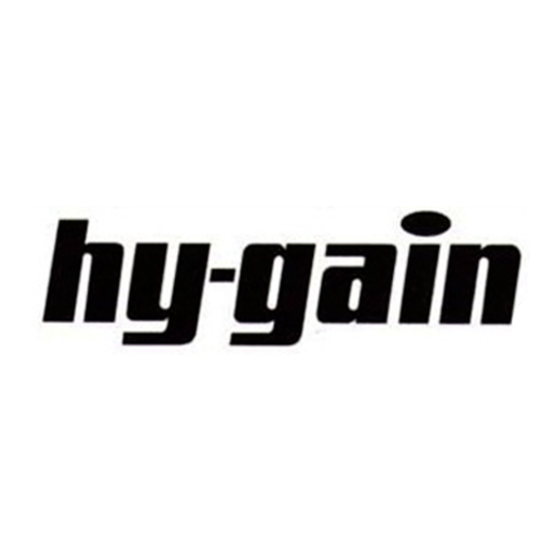Advertisement
Quick Links
,,-.,
_«()BILE STATION BI-L1NEAR AMPLIFIER
'-
This Bi-LinearAmplifier
advanced design. It utilizes an integrated circuit, two tubes, four
transistors and four diodes and a grounded grid, tuned plate
circuit for amplication for AM, FM, CW, and- SSB si~nals
The Bi-Linear
Ampl ifier will operate over the frequency range
25-54 MHz. However, it is F.C.C. Type Accepted under Parts 89,
91, and 93 over the frequency range 25-40 MHz.
Operation of this equipment requires a FCC license. Failure to
comply
is punishable by penalties set forth
Regulations of the FCC. A copy of these Rules is available from
the U.S. Government
possessionof the operator.
The 483 Bi-LinearAmplifier
shipped from the factory, and must be used with a transceiver
which is FCC Type Accepted under Parts 89, 91, and 93 for the
system to be valid.
.,....-."
A special feature of the Amplifier
change over
relay which
connections making it perfect for operation with
transceivers not having external amplifier control circuits.
Another feature is that this unit amplifies the received signal,uti-
lizing an integrated circuit
Variable plate tune and load capacitors offer impedance matching
for maximum output to varying antenna loads in the 40-70 ohm
range.
The Bi-Li near Amplifier
suppress radiation that may cause television interference. TVI
problem has been given full consideration in design and layout of
the chassis.
There are, however, some types of TVI that cannot be prevented
within the amplifier. This is particularly true in weak signal areas.
In such cases, a good commercial low passfilter is recommended.
~e.ight
,dth
Depth . . . . . . . . . . . . . . . . . . . . . . . . . . . . . . . . . . . . . .. 103/8"
NetWeight
ShippingWeight
Construction .•................
ORDER NO.
12
VDC
is precision built, compact amplifier of
in the Rules and
Printing Office
and should be in the
complies with FCC Regulation when
is the automatic antenna
operates without
special external
amplifier.
has been designed and constructed to
Lig!'ttweightaluminumchassis
with rugged steel case
INSTALLATION
483
OPERATION
HY-GAIN
Rural Route 3 •
Power Requirement
FreRuency Range
.
Types of Emission
Power Output (Slightly lessat 50 MHZ)
Amplification
Drive Requirement to Trigger An>enna Relay
Max Drive (unmodulated carrier and FM}. _,
(amplitude modulated carrier)
(amplitude modulated peak) ..
Harmonic Supression
Input Impedance (unbalanced)
Output Impedance (unbalanced)
Antenna Switching
Tube and Diode Complement
Cable Connector Data
*F.C.C.
Type Accepted for frequency range 25-40 MHz only.
low power
ASSEMBLY AND INSTAllATION:
()
Carefully
ton.
Examine
Check to insure tubes are seated in the sockets.
the plate caps on the tubes.
ternal damage.
The unit is made to operate
only.
Do not attempt to operate your amplifier until you have
read the manual and properly installed
() The location is not critical but consideration must be given to
adequate ventilation.
Allow
at least 4" of clearance
for good air circulation.
() The primary pOwer connection on the amplifier is the +12V
41/8"
DC terminal on the rear panel.
7 1/8"
() The fuse holder is provided on the hookup cable .with a.2Q
amp fqse. Do not use a larger capacity fqse or amplifier,
5 Lbs.
transfqrmer, and power supplywilinotbe
SLbs.
(). The
unit.
recommended thClt a No.
&
INSTRUCTIONS
ELECTQONICS
Lincoln.
_
AM, FM. CW, SSB. DSB
80 Watts
of Received Signal
suppressed more than 60db
nominal, lessthan 2: 1 VSWR 25-54 MHz*
nominal, Adjustable 40-70 ohms, nonreactive
Automatic provided by
_
4 Transistors, 10 Diodes
_
remove the amplifier
from the packing car-
it closely
for signs of shipping
Inspect for any signs of in-
on negative
t he unit.
IMPORTANT
on all sides of the cabinet
protected.
will
not
operCite without
12
or heavier wire be rqnfrom
CORPORATION
NElbraska 68505
+12-14V DC
15 Amp
25-54 MHz*
220 Watts
PEP, SSB, or DSB
(with 3.5 watts drive)
40
db
,1Watt
15 Watts
3.5 watts
,
..
14 watts PEP
50 Ohms
50 Ohms
RF sensing network
2 Tubes
1 Integrated Circu it
Input and Output
require MIL PL-259
damage.
Check
ground systems
grounding.
It
i$
the
Advertisement

Summary of Contents for Hy-Gain 483
- Page 1 2: 1 VSWR 25-54 MHz* possessionof the operator. Output Impedance (unbalanced) 50 Ohms nominal, Adjustable 40-70 ohms, nonreactive The 483 Bi-LinearAmplifier complies with FCC Regulation when Antenna Switching Automatic provided by shipped from the factory, and must be used with a transceiver...
- Page 2 TECHNICIAN. () This model amplifier will work with the common antenna systems designed for the 25-54 MHz*range provided the antenna The 483 Bi-Linear Amplifier is factory adjusted for the rang('..-.., has a resistive input impedance between 40-70 Ohms. The SWR 25-32 MHz.
- Page 3 SCHEMATIC LEGEND FOR PRODUCT 483 Description Part No. Symbol 150 uuf 1KV Disc Ceramic 727980 C2, 4, 5,8, 20, 28 2200 uuf 1KV Disc Ceramic 721161 56 uuf 1KV Disc Ceramic 725711 20 uuf 1KV Disc Ceramic 725717 721109 C10,11...
- Page 4 r---'U--ci9,;QO';- +CIl 101,1" 210K rf7- .weJ LAMP --------, Cisl LPOWER~ETE~ ilOOpf ga,..~?l' ~!sIUh COIL +C2e 00P f ;JiF;;;22 i' O OUfd :tCf, 0rOPF REC. PREAMP :::!.J -------------...
- Page 5 If the exciter (transceiver) ca'1110tsupply a carrier equal to the peak power of the voice SSB or DSB signal then the tune and load controls must be set for maximum output while modulating. Do not apply drive power for more than five seconds without In this case, a modulation ellVelope indicator (monitor scope) is...
- Page 6 1. The defect is not the result of misuse, neglect, accident, incorrect wiring own, improper installation or use A portion of the incoming circuit is coupled to the base of 01 contrary to instructions. sensing transistor. This causes 01 to conduct and change the bias on 02, relay transistor.



Need help?
Do you have a question about the 483 and is the answer not in the manual?
Questions and answers